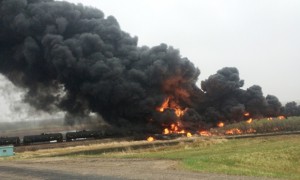Bakken oil treated before shipment, fiery derailment – Hess Corp.
Bakken oil “fully in compliant with North Dakota’s crude conditioning order.”
A shipment of Bakken oil involved in an explosive train derailment in North Dakota had been treated to reduce its volatility – a move that state officials suggested could have reduced the severity of the accident but won’t prevent others from occurring.
Hess Corporation spokesman John Roper said the oil complied with a state order requiring propane, butane and other volatile gases to be stripped out of crude before it’s transported. That conditioning process lowers the vapour pressure of the oil, reducing the chances of an explosive ignition during a crash.
Despite the treatment of the Bakken oil in Wednesday’s accident, six cars carrying a combined 180,000 gallons of oil caught fire in the derailment 2 miles from the town of small Heimdal in central North Dakota. The town was evacuated but no one was hurt.
Investigators on Thursday recovered wheel fragments from the scene. Those will be sent to a government laboratory for analysis, said National Transportation Safety Board spokesman Keith Holloway. A defective tank car wheel is suspected to have played a role in another oil train accident, in Galena, Illinois, on March 10.
The North Dakota train was travelling 24 miles an hour, Holloway said, much slower than the 50 mph limit imposed by federal regulators.
The state volatility standard went into effect last month. It came in response to a string of fiery oil train accidents, including a 2013 derailment in Lac-Megantic, Quebec that killed 47 people and a derailment and fire near Casselton, North Dakota last year.
Members of Congress have called for a stricter, national volatility standard for crude moved by rail.
Roper said the Hess shipment was “fully in compliant with North Dakota’s crude conditioning order.” It was tested immediately prior to loading onto a BNSF Railway train in Tioga and had a vapour pressure of 10.8 pounds per square inch – compared to the 13.7 pounds per square inch maximum under the state standard.
Reducing the explosiveness of crude moved by rail was not supposed to be a cure-all. Federal regulators last week announced a new rule that calls for stronger tank cars better able to withstand a derailment and more advanced braking systems to help keep fuel-carrying cars on the tracks.
“Our oil conditioning order in no way will prevent an accident,” said Alison Ritter with the North Dakota Industrial Commission, which set the vapour pressure standard. “Oil is still going to burn. That’s why the oil was produced. But it’s not as explosive.”
Democrats in Congress contend more needs to be done to reduce the danger of oil shipments by rail that pass through more than 400 counties including major metropolitan areas such as Seattle, Chicago and Philadelphia. Most of that oil comes from the Bakken region of North Dakota, Montana and Canada.
“Why do we let trains with this volatility pass through every day? Why are we letting these guys get away with that?” U.S. Sen. Maria Cantwell, a Washington state Democrat, said in an interview last week after federal regulators unveiled the braking and tank car rule.
The tank cars that burst into flames were a model slated to be phased out or retrofitted by 2020 under a federal rule announced last week. It’s the fifth fiery accident since February involving that type of tank car, and industry critics called for them to be taken off the tracks immediately to prevent further fires.







